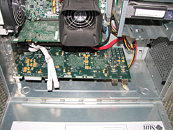Friday, June 29th 2007
Supercomputer On-a-Chip Prototype up and running
COLLEGE PARK, Md.-A prototype of what may be the next generation of personal computers has been developed by researchers in the University of Maryland's A. James Clark School of Engineering. Capable of computing speeds 100 times faster than current desktops, the technology is based on parallel processing on a single chip.
Parallel processing is an approach that allows the computer to perform many different tasks simultaneously, a sharp contrast to the serial approach employed by conventional desktop computers. The prototype developed by Uzi Vishkin and his Clark School colleagues uses a circuit board about the size of a license plate on which they have mounted 64 parallel processors. To control those processors, they have developed the crucial parallel computer organization that allows the processors to work together and make programming practical and simple for software developers.Parallel processing on a massive scale, based on interconnecting numerous chips, has been used for years to create supercomputers. However, its application to desktop systems has been a challenge because of severe programming complexities. The Clark School team found a way to use single chip parallel processing technology to change that.
Vishkin, a professor in the Clark School's electrical and computer engineering department and the university's Institute for Advanced Computer Studies, explains the advantage of parallel processing like this:
"Suppose you hire one person to clean your home, and it takes five hours, or 300 minutes, for the person to perform each task, one after the other," Vishkin said. "That's analogous to the current serial processing method. Now imagine that you have 100 cleaning people who can work on your home at the same time! That's the parallel processing method.
"The 'software' challenge is: Can you manage all the different tasks and workers so that the job is completed in 3 minutes instead of 300?" Vishkin continued. "Our algorithms make that feasible for general-purpose computing tasks for the first time."
Vishkin and his team are now demonstrating their technology, which in future devices could include 1,000 processors on a chip the size of a finger nail, to government and industry groups. To show how easy it is to program, Vishkin is also providing access to the prototype to students at Montgomery Blair High School in Montgomery County, Md.
Source:
A. James Clark School of Engineering
Parallel processing is an approach that allows the computer to perform many different tasks simultaneously, a sharp contrast to the serial approach employed by conventional desktop computers. The prototype developed by Uzi Vishkin and his Clark School colleagues uses a circuit board about the size of a license plate on which they have mounted 64 parallel processors. To control those processors, they have developed the crucial parallel computer organization that allows the processors to work together and make programming practical and simple for software developers.Parallel processing on a massive scale, based on interconnecting numerous chips, has been used for years to create supercomputers. However, its application to desktop systems has been a challenge because of severe programming complexities. The Clark School team found a way to use single chip parallel processing technology to change that.
Vishkin, a professor in the Clark School's electrical and computer engineering department and the university's Institute for Advanced Computer Studies, explains the advantage of parallel processing like this:
"Suppose you hire one person to clean your home, and it takes five hours, or 300 minutes, for the person to perform each task, one after the other," Vishkin said. "That's analogous to the current serial processing method. Now imagine that you have 100 cleaning people who can work on your home at the same time! That's the parallel processing method.
"The 'software' challenge is: Can you manage all the different tasks and workers so that the job is completed in 3 minutes instead of 300?" Vishkin continued. "Our algorithms make that feasible for general-purpose computing tasks for the first time."
Vishkin and his team are now demonstrating their technology, which in future devices could include 1,000 processors on a chip the size of a finger nail, to government and industry groups. To show how easy it is to program, Vishkin is also providing access to the prototype to students at Montgomery Blair High School in Montgomery County, Md.

20 Comments on Supercomputer On-a-Chip Prototype up and running
What we really need is to get SSDs big and cheap. Hard drives need a huge boost. Everything else is up-to-speed.
Any idea how far away these are from becoming mainstream?
however, it is neither big or cheap... but it is a start
"University of Maryland researchers now heading video card behemoth ATI."
:D The 8800GTSx1000 :rockout:
Anywho, just stating the obvious I guess. Everything is headed in the multi-core / parallel processing direction anyway.... just hoping to see more development for graphics cards in that area. It seems the focus in the last year or so, has been on multiple cores and heat/power reduction (90nm vs 65nm etc) for CPU's, but haven't seen as much development in those same areas for video cards. :ohwell:
LOL
Let me know when you buy that microscope - I might want to borrow it someday. I don't know if you can view transistors in a traditional (optical) microscope though as transistors in a GPU nowadays are in the 80nm range and visible light is more like 500nm. I think you should be able to view it with an electron microscope though.